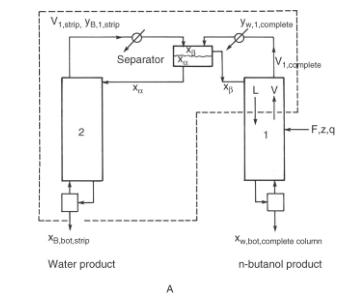We will use a system similar to Figure 8-5A, except both columns have direct reflux from their
Question:
We will use a system similar to Figure 8-5A, except both columns have direct reflux from their condensers in addition to reflux from a decanter. Distill a feed that is \(17.0 \mathrm{~mol} \%\) water and \(83.0 \mathrm{~mol} \%\) furfural \(\left(\mathrm{C}_{5} \mathrm{H}_{4} \mathrm{O}_{2}\right)\). The feed flow rate is \(200.0 \mathrm{kmol} / \mathrm{h}\) and is at \(42.0^{\circ} \mathrm{C}\) and \(1.0 \mathrm{~atm}\). Furfuralwater forms a heterogeneous azeotrope. Use NRTL-RK for equilibrium. Bottoms from column 1 is a furfural product. The total condenser produces a saturated liquid, and saturated liquid distillate from column 1 is sent to the decanter. The water layer (liquid 1) from the decanter is fed to column 2. The decanter is adiabatic at \(1.0 \mathrm{~atm}\). Furfural (liquid 2) has a threshold of 0.5 . The furfural layer is a feed (above) stage 2 (in Aspen notation) of column 1.
Figure 8-5A

Distillation column 1 operates at a constant pressure of \(1.0 \mathrm{~atm}\). Column 1 has six stages (Aspen notation), a kettle reboiler, and a total condenser. The feed enters above stage 3, and the furfural layer from the decanter is fed above stage 2 (both Aspen notation). Use the total condenser to condense the distillate before it is sent to the decanter.
Distillation column 2 operates at a constant pressure of \(1.0 \mathrm{~atm}\). Column 2 has six stages (Aspen notation), a kettle reboiler, and a total condenser. The furfural layer from the decanter is fed above stage 2 (Aspen notation). The boilup rate in column 2 should initially be set to \(4.0 \mathrm{kmol} / \mathrm{h}\). Use the total condenser to condense the distillate and then send it as a second feed to the decanter. Reduce the reflux ratios in both columns to the final values of 0.01 .
Once you have convergence and final reflux ratio values, change the boilup rate in column 2 to obtain products that are \(99.5 \mathrm{~mol} \%\) furfural or slightly higher and \(99.0 \mathrm{~mol} \%\) water or slightly higher. Report:
a. Final reflux ratio in column 1 and final reflux ratio in column 2.
If these values are not 0.01 or less, you have not finished the problem.
b. Flow rates of the furfural product and the water product in \(\mathrm{kmol} / \mathrm{h}\).
c. Boilup rate in column 2 (column producing the water product) in \(\mathrm{kmol} / \mathrm{h}\).
d. Mole fraction of the water in the furfural product and mole fraction of the furfural in the water product.
e. Flow rate of column 1 distillate (column producing the furfural product) in \(\mathrm{kmol} / \mathrm{h}\).
f. Column 1 condenser and reboiler temperatures in \(\mathrm{K}\).
g. Outlet temperature of the decanter in \(\mathrm{K}\).
h. Molar ratio of the water phase/total liquid in the decanter.
Step by Step Answer:

Separation Process Engineering Includes Mass Transfer Analysis
ISBN: 9780137468041
5th Edition
Authors: Phillip Wankat





